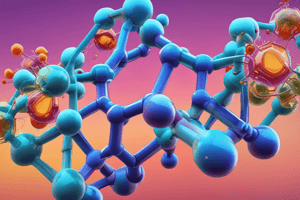Podcast
Questions and Answers
What do pyrrole substitution reactions typically exhibit in terms of selectivity?
What do pyrrole substitution reactions typically exhibit in terms of selectivity?
- Variable regioselectivity (correct)
- Universal α-selectivity
- Universal β-selectivity
- No selectivity
Why is the intermediate formed by electrophile attack at C-2 of pyrrole more stable than that from C-3?
Why is the intermediate formed by electrophile attack at C-2 of pyrrole more stable than that from C-3?
- It undergoes faster reaction
- It is less sterically hindered
- It has fewer substituents
- It is stabilized by charge delocalization (correct)
Functional substituents influence pyrrole substitution reactions similarly to which other compound?
Functional substituents influence pyrrole substitution reactions similarly to which other compound?
- Cyclohexane
- Hexane
- Benzene (correct)
- Naphthalene
What characterizes the directing influence of functional substituents on heterocyclic ring substitution?
What characterizes the directing influence of functional substituents on heterocyclic ring substitution?
In the reactions described, how are the substituents in the thiophenes positioned?
In the reactions described, how are the substituents in the thiophenes positioned?
Which of the following compounds is considered a saturated derivative of pyrrole?
Which of the following compounds is considered a saturated derivative of pyrrole?
What is the primary bioactive function of ranitidine?
What is the primary bioactive function of ranitidine?
Which rule do pyrrole, furan, and thiophene follow that classifies them as aromatic compounds?
Which rule do pyrrole, furan, and thiophene follow that classifies them as aromatic compounds?
Which compound is known to treat parasitic worms in livestock?
Which compound is known to treat parasitic worms in livestock?
Thiophene can be industrially synthesized through a reaction between which two substances?
Thiophene can be industrially synthesized through a reaction between which two substances?
What is the boiling point of thiophene?
What is the boiling point of thiophene?
Which of the following compounds is not a bicyclic compound?
Which of the following compounds is not a bicyclic compound?
Which of the following statements is true regarding the formation of resonating structures in these compounds?
Which of the following statements is true regarding the formation of resonating structures in these compounds?
What is the basic unit of the porphyrin system?
What is the basic unit of the porphyrin system?
Which reaction occurs readily with furan?
Which reaction occurs readily with furan?
Which of the following represents the correct reactivity order of the five-membered heterocycles for electrophilic substitution?
Which of the following represents the correct reactivity order of the five-membered heterocycles for electrophilic substitution?
Which reaction can cause N-protonation in pyrrole?
Which reaction can cause N-protonation in pyrrole?
What is a common method to prepare furan?
What is a common method to prepare furan?
Which position on the rings of furan and thiophene is preferred for substitution?
Which position on the rings of furan and thiophene is preferred for substitution?
Which of the following statements is true about pyrrole?
Which of the following statements is true about pyrrole?
Which of the following compounds is prepared from pyrrole by substitution?
Which of the following compounds is prepared from pyrrole by substitution?
Study Notes
Structure and Types of Five-Membered Heterocycles
- Pyrrole, furan, and thiophene are the simplest five-membered heterocyclic compounds, each featuring one heteroatom.
- Saturated derivatives: pyrrolidine (pyrrole), tetrahydrofuran (THF) (furan), and thiophane (thiophene).
- Bicyclic compounds: indole (pyrrole fused with benzene), benzofuran (furan fused with benzene), benzothiophene (thiophene fused with benzene).
- These compounds exhibit aromatic properties, adhering to Huckel's rule (4n+2 π electrons).
Bioactive Compounds Containing Heterocycles
- Ranitidine: an H2-receptor antagonist used for lower stomach acid levels, effective in treating ulcers.
- Ketorolac: a potent analgesic and anti-inflammatory medication.
- Pyrantel: an anthelmintic agent administered to eliminate parasitic worms in livestock.
Sources and Synthesis
- Pyrrole and thiophene are found in coal tar, with thiophene present in about 0.5% of ordinary benzene from fractional distillation.
- Industrial synthesis of thiophene can occur by the high-temperature reaction of n-butane with sulfur.
- Pyrrole can be synthesized through various methods, including being a fundamental component of porphyrins, present in biomolecules like hemoglobin and chlorophyll.
- Furan is primarily produced through decarbonylation of furfural, derived from pentosans.
Electrophilic Substitution Reactions
- Pyrrole, furan, and thiophene are reactive with electrophiles, undergoing nitration, halogenation, sulfonation, and Friedel-Crafts acylation.
- Reactivity order for electrophilic substitution: pyrrole >> furan > thiophene > benzene.
- Pyrrole displays exceptional reactivity, allowing it to react with iodine and form 2-acetylpyrrole in the absence of a catalyst.
Substitution Preferences and Mechanisms
- Substitution most frequently occurs at the 2-position (α) for furan and thiophene compounds.
- Pyrrole's reactions require care, as N-protonation can disrupt its aromatic properties.
- N-protonation is often performed before other reactions; N-acetylpyrrole can be formed via interactions with acetic anhydride or acetyl chloride.
- The mechanism explains regioselectivity in electrophilic attack: C-2 intermediate exhibits more stabilization through charge delocalization than C-3.
Influence of Functional Substituents
- Functional groups impact substitution reactions in a manner similar to benzene, affecting regioselectivity.
- Different substituents (e.g., electron-donating or electron-withdrawing groups) alter the orientation and outcome of the reactions involving heterocycles.
- Observations reveal the directing influence of substituents in curvature and position for both thio- and pyrroles.
Studying That Suits You
Use AI to generate personalized quizzes and flashcards to suit your learning preferences.
Related Documents
Description
Explore the structure and types of five-membered heterocycles, focusing on compounds like pyrrole, furan, and thiophene. The quiz also covers their bioactive derivatives such as ranitidine and ketorolac, as well as the sources and synthesis methods of these important chemical compounds.




